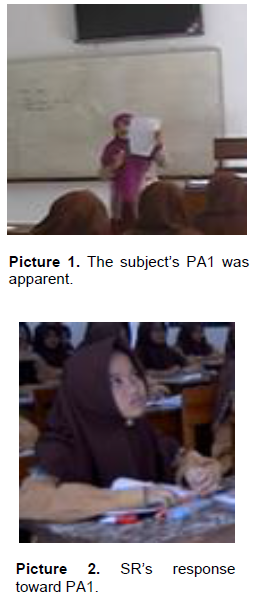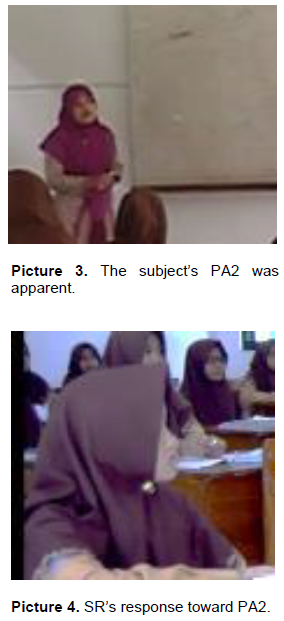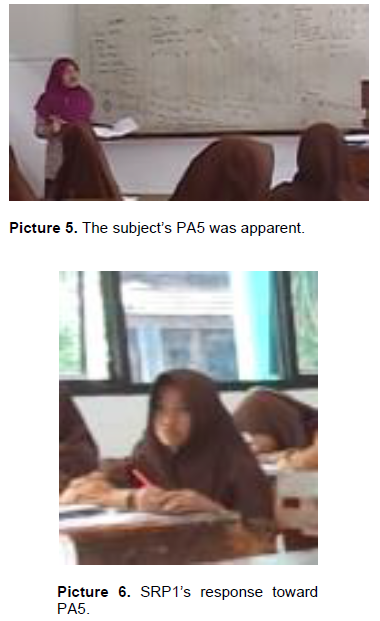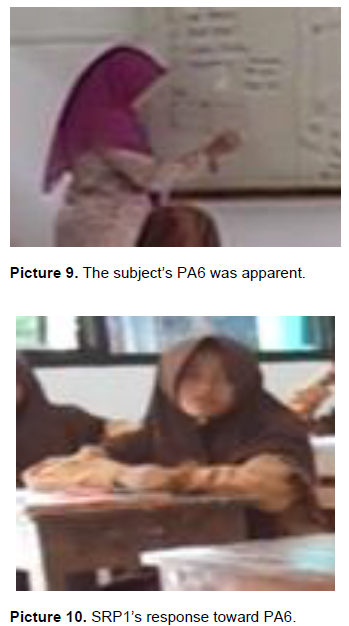Various methods of teaching had been implemented to create an active and fun teaching process by teachers for students. Teachers’ actions during class could lead to different responses from students. However, those actions are not always well accepted by students. Valsiner suggested a theory on a set of teachers’ actions for promoting students’ response called zone of promotion action (ZPA). The characteristics of the teacher’s ZPA were not imbedded, indicating that the students could accept, reject or respond in a pseudo manner. This study aims to identify the forms of promote action which had pseudo responses called teacher’s pseudo promote action (P-PA). Data were collected by interviewing teachers and students. The teaching process was observed through video recording. The subject of this study was a novice teacher and three students with high, moderate, and low math skills. The result showed that P-PA was dominant on the student with low math skill. This was apparent when she was silent, behaving as if she did not pay any attention to her teacher but she actually got the concept. She partly followed the teacher’s instruction, and got answers from her classmates to complete the task, so that it seemed as if she understood the concept that was given.
Learning is a process of acquiring insights and experience to change people’s behavior through interaction with the environment. This occurs in cognitive, affective, and psychomotor aspects. Students interact with their surroundings in order to acquire new information and experience. Learning is a complex activity which results in students having skill, knowledge, attitude, and values. These capabilities are derived from the stimulus provided by the environment and a cognitive process provided by the teacher. Hence, through teaching and learning process, students would change for the better.
Suherman (2003) proposed two kinds of learning: learning to accept and learning to find. In learning to accept, students would only learn by accepting all information their teachers provide. Thus, they would only memorize the given concept. However, in learning to find, they would seek to find the concept learned with their teachers’ guidance.
Students would not only memorize, but also have meaningful learning; they will learn the concept developed in another context. Therefore, it is expected that they could have better understanding and apply the concept they learn in real life.
Mathematics is necessary for students because it provides them with logical, analytical, systematical, critical, and creative thinking abilities and also ability to cooperate. Hence, in teaching mathematics, students should be made to learn by finding in order to make them truly understand the given process from the origin of the concept up to its implementation. This should make teachers realize their role as motivator and preceptor for students in learning mathematics. Teachers should implement teaching methods which will make students active to achieve teaching and learning objectives.
Mathematics teaching is a process of interaction between teachers and students in a learning environment. It involves evolving mindset and logic through various methods for mathematics learning program to grow and develop optimally and for students to be able to do learning activities effectively and efficiently (National Education Law, 2003). In teaching mathematics, students are made to understand the nature of a number of objects. Tools are provided for students to understand or explain an information (for example, equation or table in mathematical models as the simplicity of word problems).
Learning mathematics does not only involve having calculation skill, but also includes being proficient in mathematical thinking and reasoning to solve new problems and learn new things which students might see in the future. Some studies showed that whatever teachers teach in class influences students’ learning both the mathematics concept given and chances to understand mathematics as a discipline (Goos et al., 2007).
Yackel and Cobb (1996) conducted a research, and found that daily practices and routines during class play an important role in how students understand and learn mathematics. Students construct mathematical knowledge and the discourse of norms in relation to daily practices. Whatever students learn mostly depends on their teachers’ experience in teaching. In order to achieve high-quality mathematics education, teachers need to:
1. Deeply understand the field they teach
2. Understand how students learn mathematics, including finding out how their mathematical skill grow individually, and
3. Select tasks and strategies which can improve the quality of their teaching process (NCTM, 2000).
Various teaching methods had been implemented to create an active and fun teaching process. Van de Walle (2002) stated that teachers should change their approaches from teacher-centered to student-centered. Goos and Bennison (2012) suggested that a teaching process needs to be interactive between teacher and students. Teachers’ skills in delivering material, managing the teaching process, and controlling students during class are influenced by several factors, including teachers’ educational background, teaching experience, educational qualification, and class governance (Nadeem et al., 2011; Leong, 2013; Lamb and Fullarton, 2002).
These are not always well accepted by students. Valsiner (1997) suggested two zones to explain the development of students’ interaction with their physical environment and other people: Zone of Free Movement (ZFM), representing the environmental constraint which limits the freedom to act and think; and Zone of Promoted Action (ZPA), a set of activities promoted by adults to promote new skill. Valsiner (1997) claimed that ZPA is a set of activities, things and area in an environment, in which individuals’ actions are displayed. On the other hands, Blanton (2005) argued that this concept of ZPA refers to a set of activities provided by teachers to make students act in particular ways. Thus, it was stated that ZPA is a set or a number of teachers’ actions (promote action /PA) provided for students
Goos (2005) defined ZPA as a set of activities offered by adults to promote new skills. Teachers implement some procedures during teaching process. However, they are not always categorized into ZPA. Some teaching methods included in ZPA are referred to activities which make students act and behave with the aim to acquire new skills.
This ZPA was not imbedded, which could either be accepted (accepted promote action/A-PA), or rejected (rejected promote action/R-PA) by students. Additionally, there is another condition, referred to as pseudo response (pseudo promote action/P-PA). It is difficult to see this condition directly during teaching, because with it students act as if they accept their teachers’ promotion action, but do not accept their teachers’ instruction. It is necessary conducting this study because when students are identified, feedback would be obtained, and, thus, would make the teachers to revise their teaching. This present study focuses on P-PA since this condition needs to be identified and is not apparent during the teaching process.
Although teachers determine the kinds of PA that would be implemented in class, it does not mean that such PA would be positively responded to by all pupils in a class. This could be solved by guiding the students to follow or modify the existing PA. Teachers can only determine the PA to be implemented based on the level of students’ development in the teaching process. If what they implement is far beyond the students’ understanding, an optimal development would not happen.
Some studies on teachers’ ZPA had been conducted. Based on the results of those studies coupled with the teaching components consisting of teaching objectives, materials, methods, media, and evaluation, the author took some indicators of the form of teacher’s promotion action for this study as shown in Table 1.
Teacher’s promote action described earlier would result in students’ various responses. They include: giving attention, internal process of learning activities such as correlating between concepts, solving problems, answering teachers’ questions, manipulating mathematical models, representing mathematical objects, and concluding information acquired. Such responses could not be separated from teacher’s promotion action. It could be shown in three forms as follows:
1. The students accepted the teacher’s promote action or accepted promote action (A-PA) by conducting a particular instruction given by the teacher, participating actively, and paying attention to the teaching process.
2. The students rejected the teacher’s promote action or rejected promote action (R-PA) apparently by not conducting particular instruction given by the teacher, and doing another activities not related to the teaching material.
3. The students responded to the teacher’s promote action in a pseudo manner or pseudo promote action (P-PA) apparently by acting as if they accepted the promote action, but it was actually not.
From the above, the author only focused on identifying the students’ pseudo response to the teacher’s promote action (P-PA).
This study is a descriptive qualitative research. The author described the teaching process conducted by a teacher and identified which teaching procedures were categorized into the teacher’s PA. Next, the author took the teacher P-PA as the focus of an in-depth examination. The subject of this study was a novice teacher in one of the junior high schools in Jombang, East Java, Indonesia. The novice was categorized based on years of teaching experience which range between 1 to 5 years. The teaching was conducted on first grade students of junior high school, and three students with high, moderate and low math skills responded to the teaching. This study was conducted by having an interview with the subject based on the teaching plan. This plan includes teaching materials, methods and teaching scenario that were implemented. After conducting the interview, the subject did the teaching in class and the author observed the process. This observation focused on every procedure of the teaching which was identified and categorized into PA the author had predetermined. The study observed the three students with different mathematical skills and collected data in the form of their responses categorizing them into A-PA, R-PA, or P-PA.
After completing the teaching process, the author had an interview with the teacher and the students on the teaching process that had just been conducted. The interview done with the subject was to know whether the teaching-learning process succeeded or not, and to confirm the subjects’ action during the process. This was conducted to know if the teacher would likely change the teaching procedures in class, thus, it would not correspond to the initial planning. The interview with each of the three students was conducted to confirm their responses or action during the teaching process. The result of that observation was still assumption, and it would be confirmed after having the interview, whether it was A-PA, R-PA, or P-PA. Besides categorizing, the researcher analyzed under which condition the students might show such responses.
Data collection was conducted through observation which involved field note, teaching recording, and interview with the teacher and students as well. The author focused on identifying the subject’s pseudo promote action (P-PA) based on responses gathered in the form of the students’ behavior with high, moderate, and low math skills.
The teacher taught the first grade student to identify plane elements. The result of the pre-teaching interview showed that the teaching was conducted by identifying and implementing question-answer technique. The only plane identified classically was rectangle. Whereas, the other planes were provided, identified, and ultimately presented in groups.
The teacher began the teaching process by praying, checking the number of students present, and reviewing the previous material taught, which was triangular sides. Subsequently, the teacher presented the material that was discussed for the day. It was rectangular. She asked the students to mention the features of rectangle. The subject-matter of the teaching was to define and list the characteristics, circumference and area of rectangle. The teacher utilized a rectangular paper as the medium and named each of its angles. She began to define rectangle by folding the paper vertically and it was found that it had four congruent angles and two congruent sides.
Next, the teacher asked the students to investigate the characteristics of rectangle from its diagonal and determine which angles face each other. It was further investigated that each angle was 90°C. Furthermore, the teacher asked the students to identify the symmetry fold of the paper. There were two folded symmetries. In addition, the subject also asked the students to identify the rotational symmetry of the paper, and it resulted in two rotational symmetries. It was rotated up to 180°C and 360°C.
The teacher went on to the formulation of circumference and area of the rectangle. However, the subject directly provided some problems for the formulation of the rectangle area. Sometimes, in the process of identification, the teacher gave chances for the students to ask what they did not understand in the material. The subject asked them to note the material given as well. The teaching process conducted is shown in Figure 1. During observation, the author signed that the promote action on the indicator was not always conducted by the subject. Overall, the promote actions apparent were number 1, 2, 5, 6, 8, 10, and 12. Subsequently, the author analyzed the video recording that corresponded to the observation note and was used as content of arranging questions for the interview. Following the interview, the author determined the category of the subject’s promote action based on the students’ responses. The category might be in the form of acceptance, rejection, or pseudo. The researcher merely focused on the students’ pseudo promote action (P-PA). It seemed that P-PA was apparently on number 1, 2, 5, and 6.

The author showed the result of the analysis with code S as the subject/teacher, H as the student with high math skill, M as the student with moderate math skill, L as the student with low math skill and A as the author. Promote action on number 1 was asking the students to correlate the example provided with the material to discuss. This was categorized into P-PA for the student with low math skill. The following was the excerpt of the teaching process and the interview with the student:
Teaching process recording
S: This is for long-square. This is the plane, ok. First, you need to find the definition of this plane. Then, you need to identify its features. Third, we seek to find the circumference and the area of this plane. For instance, I name this plane as ABCD. So, what is long-square?
L: (keep silent) (Pictures 1 and 2).
Post-teaching interview with the students
A: This is long-square, isn’t it? Why is it called long-square?
L: Because both its top and bottom sides are all long.
A: Is this long, is this long?
L: Both the right and left sides as well.
A: Do you mean the length is equal or else?
L: The length is equal.
Based on the Pictures 1 and 2, the subject seemed to ask about the shape of long-square by displaying a paper. L could not clearly correlate the example with the material presented and pretended as if she understood the content; however, when it came to the interview, L could no correctly answer the question given or merely answered without any understanding of the material. This was revealed after conducting the post-teaching interview, and L admitted that she copied her classmate’s answer. It showed that the student just followed her friend when correlating the example with the material given. It also showed that L gave pseudo response toward the subject’s/teacher’s promote action. Hence, the PA was also showed that L gave pseudo response toward the asking the students to explore their knowledge throughthe teacher’s given prerequisite questions/previous material. This PA got pseudo response from the students with the low math skill as well. The following was the excerpt of teaching recording and the interview with the low math skill student.
Teaching recording
S: And for today, we have come into long square. So, today we are going to discuss long-square. Ok, what can you see on long-square? I am sure you know the shape of long-square.
L: (the student kept silent) (Pictures 3 and 4).
Post-teaching interview with student
A: Where are the angles of long-square?
L: Its above, under, and beside
A : If we use this, where are the angles?
L: These are the angles
A: So, these all are the angles. How many are they?
L: there are 4.
As presented in Pictures 3 and 4, the subject asked about the shape of rectangle. At that moment, the subject had not present the concept of rectangle yet, hence, the students used their existing knowledge. The excerpt of the interview and the teaching recording noted that L seemed quiet as if ignoring the subject; whereas, in the interview, L was able to show some features of identified rectangle. L seemed quiet as if ignoring the subject but she, in fact, was able to see the correlation between the material and the previous one. This showed the L gave pseudo response to the subject’s promote action. Thus, the subject’s PA was categorized into P-PA. Promote action number 5 was asking the student to note and explore the material presented on board; however, it got pseudo response from the student with low math skill. The following was the excerpt of the teaching process and the transcript of the interview with the student.
Teaching process recording
A: Note this first!
(the students wrote)(Pictures 5 and 6).
Post-teaching interview with the student
A: The teacher had written this material yesterday, right? Did you write yesterday?
L: Yes, I did
A: did you write all?
L: Not yet. I did not write the task yet.
A: Why did not you complete your writing?
L: I was confused. I wanted to complete the task but the time was up.
The subject asked the students to note the concept presented on the board. Both the teaching recording and the interview showed that L noted on her book but she did not complete it because her time was up. L noted on her book but it was not completed. She did the instruction but not completely. This showed that L gave pseudo response to the subject’s promote action, thus, the PA was categorized into P-PA. Promote action number 6 was by giving an instruction, The subject asked the student to formulate the given concept. This PA got pseudo response from the students with moderate and low math skills. The following was the results of the teaching recording and the interview with the moderate math skill student.
The teaching process recording
S: Do you know what the angles of the long-square are?
M: (kept silent)
S: ÐA=Ð B=Ð C=Ð D. Besides, if these are all congruent, I’d like to ask you, how is the degree of each angle?
M:90°C
S: How could you say that it is 90o and where did you get that? You may prove with this way. I will take this, a long-square. Here, how large is the angle of long-square?
M: (keep silent)
S: There are 4, right?, when I fold this, it will be side-by-side … (the subject helped the students to prove the large of the long-square’s angle) (Pictures 7 and 8).
Post-teaching process interview
A: Ok, what about the angle?
M: It is at the corner
A: How many are the angles?
M: it is 4
A: Ok, how big is it?
M:90°C
A: How could you know that it is 90O?
M: Because it is all 360O and it is divided by 4 resulting in 90°C
The results of the recording and interview showed that the subject directed the students to formulate the angles of rectangle. The students were more likely to be quiet and did not respond, as if ignoring the subject. However, she mentioned one of the components of rectangle, which was in terms of identifying the degree of the rectagle angles, in the interview. This showed that the student gave pseudo response and it was categorized into pseudo promote action.
This similar promote action had pseudo response from the student with low math skill as well. The following was the excerpts of the teaching process recording and the interview with the student.
Teaching recording
The student kept quiet and ignored the teacher’s direction (Pictures 9 and 10).
Post-teaching interview
A:Do you know what the fold symmetry is?
L: It is folded
A: How does make it folded?
L: As like this
A: If it is this way, is this the fold symmetry? So, what is the fold symmetry? Is it just simply folded?
L: yes, it is the same.
A: Which one is the same?
L: These, and these are same in length.
A: Are these the same in length?
L: Yes
A: So, where is another one?
L: These are same as well.
A: These and these are the same, these and these are the same as well. It is for the fold symmetry.
The results of the recording and the interview showed that the student just kept quiet and ignored the subject’s direction, seemed like to be daydreaming and had no concentration at all. However, she could answer, although not completely, the question during the interview. At the end of the interview, the student admitted that she just copied her friend’s answer. This showed that the student gave pseudo response toward the subject’s promote action, thus, it was categorized into P-PA. The following was the structure of the subject’s P-PA during the teaching process in terms of identifying the features of long-square Figure 2.
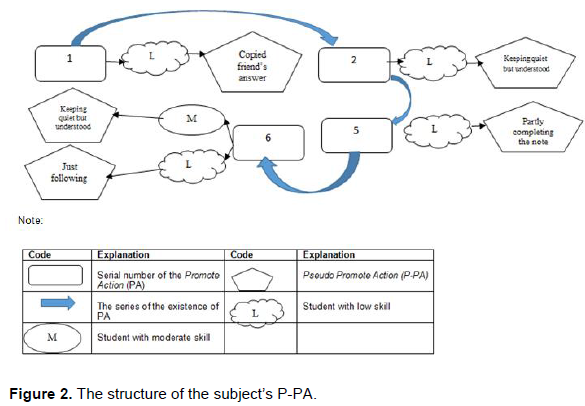
The students showed pseudo responses categorized into P-PA when they kept quiet without showing any expression. when the student copied her friend’s answer in order to answer the researcher’s questions or she just followed her friend so the she seemed to give positive response to the instruction; and when the student just partly did the subject’s instruction due to limited time. The result of the analysis earlier mentioned is presented in Figure 3.
This P-PA did not exist for the student with high math skill since she could clearly showed her acceptance and rejection of the teacher’s action. In addition, she was more dominant in accepting the subject’s PA. Based on the chart above, it showed that the student with low math skill was more likely to give pseudo response toward the subject. This was related to her low skill, her level of courage and motivation.


